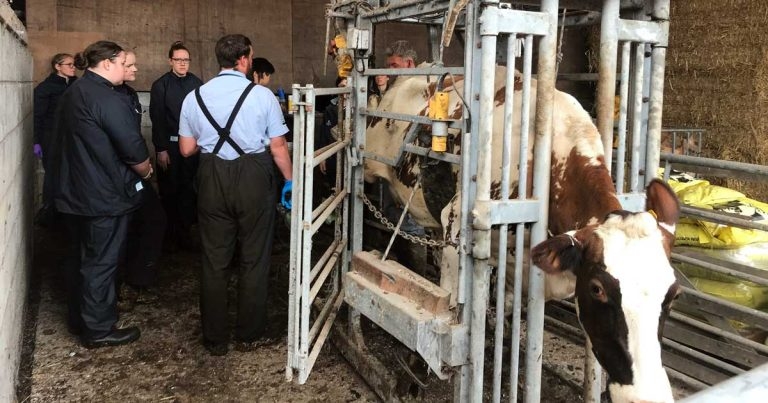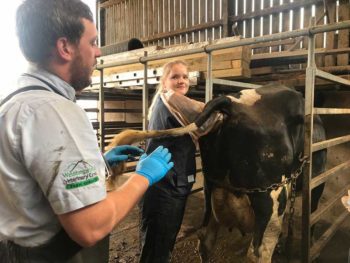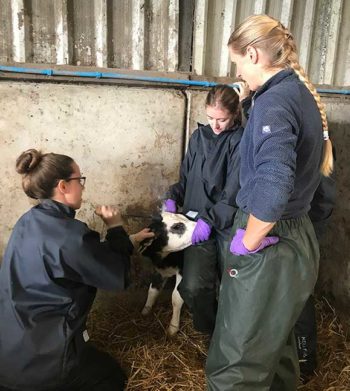10 Jan 2022
Rebecca Howard VetMB, MA, MRCVS details the Farm Vet Academy Practical Farm Skills Week designed to fill the EMS placement gap due to COVID-19.

A foot trimming demonstration.
In the team at Westmorland Veterinary Group, we recognise the significant role EMS plays in the education of vet students and preparing them for their transition postgraduation. Our farm team specifically appreciated the practical aspects of clinical farm work that they benefited from during EMS placements.

The COVID-19 pandemic resulted in substantial disruption to all vet studies, as well as the cancellation of EMS placements. This resulted in many students aiming to enter farm animal practice missing this work experience, and so lacked confidence in their production animal clinical skills.
At this point, following a bit of research, a gap in the market appeared to exist, along with a definite demand among students for extra tuition in this area. It was decided to organise a week of practical farm veterinary skills during September and we crossed our fingers that restrictions would ease.
The Farm Vet Academy Practical Farm Skills week was designed with students in mind, rather than as CPD for practitioners, and needed to be accessible and affordable. The decision was, therefore, made to focus on raising the profile of the practice with the provision of a fantastic course with less focus on profitability.

Spaces were limited to 10 students to allow transport in 3 cars and a split into 2 small groups to allow excellent exposure to the practical tasks. The focus would be on topics that we wished we had covered in a more clinically relevant way as a student and that would make the transition from student into farm vet a bit easier.
Being based in the Lake District, the students also had the opportunity to enjoy the beautiful area around us and the week included an evening schedule of social activities. These ended up being perfect for continuing clinical conversations that had arisen during the day in more depth, as well as helping the group bond with us and each other, forming a very supportive learning environment.
Teaching was for the most part provided by our vets; however, we did also benefit from fantastic support from Ceva Animal Health, which also helped make the flyer. Kate Poyser (Ceva senior territory manager) joined us on farm and was a great help; she also discussed areas of industry that the students were interested in. Hipra kindly ran the postmortem day.
We spent most of each day on local farms to keep the course as practical as possible and followed up these practical sessions with classroom-based activities and follow-up lectures.
Lunch at the practice on day one provided the chance for introductions and interesting discussions about our varied experiences starting our first jobs.
Teaching then commenced with a presentation on how to discuss ovine reproduction with farmers and then moved into our farm animal clinical room for practical sheep clinical exams, including tup fertility testing.
Tuesday morning was spent on one of our most progressive dairy farms, where we gave the students time to critically appraise the farming system – particularly focusing on building design and youngstock health. We split into groups to complete disbudding, castration and respiratory scoring of calves.
Kythe Mackenzie from Ceva continued the calf health theme with an afternoon classroom-based workshop on calf fluid therapy. We also used the opportunity to plate up milk samples we had taken during the morning to be looked at later in the week and to analyse blood samples taken from calves.
Thursday provided practical postmortem skills for the students, focusing on the bovine respiratory system. After some classroom-based theory, we headed to the local fallen stockyard, which provided plenty of carcases for examination and gave us a larger teaching space.
We concentrated on how to safely carry out the examination, which samples to take, and the gross pathology of some of the most common pathogens. This session was sponsored by Hipra.
After sessions on “farm veterinary emergencies”, and some practical tips on how to organise your car and prepare for work, the week was finished with “the most helpful clinical exam of the cow”. This allowed us to summarise and bring together everything that had been covered during the week.
It was brilliant to meet such an enthusiastic and engaged set of students who were so keen to take part and asked questions that made us think. The feedback received has been brilliant, with all students stating they learned a great deal and have grown in confidence.
The teaching that we provided focused on what was most clinically relevant for the first year in general practice and, therefore, was designed to give the students more confidence; students seemed to agree that we achieved this in their feedback.
We were really pleased that students have praised the week as providing a safe space for questions and for even the least confident students to practise practical skills without feeling that they are being judged or assessed. The hardest part of the course was organising the logistics and accommodation, as our students arrived by public transport and so were without cars; however, we feel it is important that students in this position are not excluded.
After such a success, we will certainly look at repeating this course in the future.